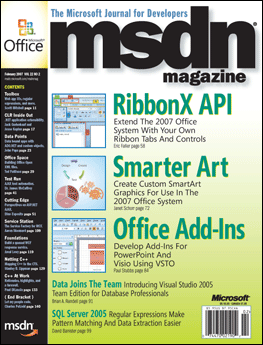My February 2007 Data Points column has been posted to the MSDN Magazine web site. This edition is titled “Data Bound Applications with ADO.NET and Custom Objects”.
Here is the beginning excerpt of the article on MSDN Magazine:
The Windows Forms binding controls are vastly improved descendents of the data binding controls of the past. They get you going quickly and handle the redundant tasks associated with setting up forms, and you can customize and extend their behavior significantly. Data can travel in a variety of containers, including DataSets and custom class entities, and the Windows® Forms binding tools allow you to bind to all of these types of objects. If you don't want to use a DataSet, you can create custom entities to be used as the data store for your application, and you can use List<T> and other collection types to store a set of your custom entities. These types of custom entities can easily be bound using the BindingSource and the BindingNavigator. In this column I'll demonstrate how to bind a custom list of business entities using the binding tools present in the Microsoft® .NET Framework 2.0, and I'll do so by writing a fully functional data-driven Windows Forms application.
I describe a Windows Form sample application, in particular its use of the DataGridView and the BindingSource and BindingNavigator binding controls. Then I walk through the lower tiers and demonstrate how they are architected and how the data is retrieved, persisted, accessed, and sent back to the database. All code for the sample application is included in this issue's download file.






